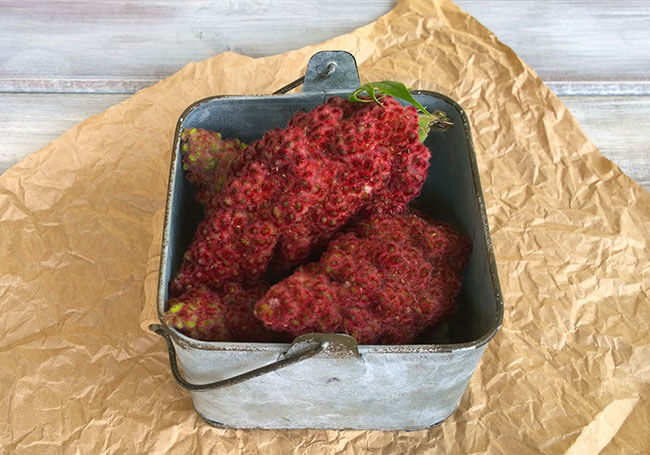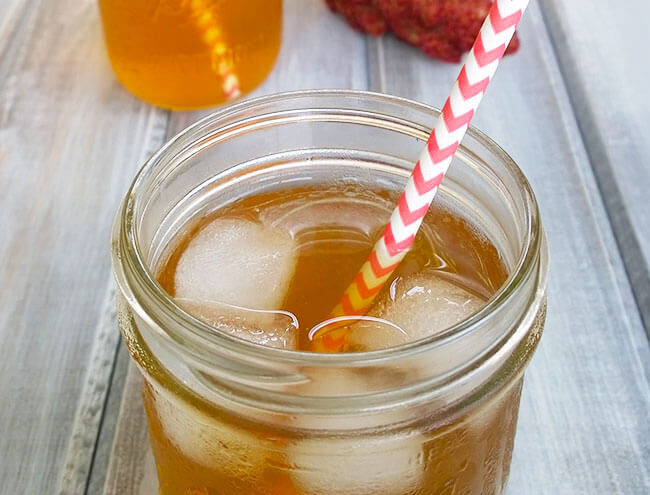
Something I look forward to the most every July is sumac season. These brightly colored, tart berries not only make a delicious lemonade, but they’re also loaded with vitamin C. So brew a batch and sip away!
Isn’t it poisonous?!
You may have only ever heard the word sumac in conjunction with the phrase “poison sumac,” but this is grossly misleading. Poison sumac has off white berries and can only be found in very wet, marshy areas, so it takes some trying just to even find it. Staghorn and other varieties have red berries and aren’t at all poisonous.
How to harvest sumac
Even if you’re not a pro at identifying wild plants, it’s super easy to tell the two apart. I’ve never actually seen poison sumac myself, even though I’ve seen hundreds of staghorn sumac trees. Just look for the distinct red berries from June to August. You’ll want to harvest them before the rain, as this will wash off the flavor.
There are many different varieties of edible sumac. You can see some of the most common ones and how to identify them here. In my area of the Midwest, the staghorn sumac is what’s available, while in the south, shining sumac is more common.
Health benefits of Sumac
So now that we’ve clarified it’s definitely not going to kill you and how to find it, let’s talk about what makes it so good for you. If you get the juice from the berries on your fingers, you’ll notice a distinct sour taste, which is because of the malic acid on the berries. This acid is tangy, but it’s also great at boosting the immune system.
Sumac is high in antioxidants that help fight inflammation in the body and disease causing free radicals. All parts of the plant can be used medicinally. The bark and leaves are both astringent due to the amount of tannins, while the berries are high in Vitamin C. It was used by the Native Americans as a gargle for sore throats, other natural remedies, and as a tea.
“It was also used medicinally by North American native people in the treatment of bacterial diseases such as syphilis, gonorrhea, dysentery, and gangrene.” (source)

Confession time
I can attest to the fact that sumac really does work well as an immune booster and cold fighter. When I was working as a nanny full time, I felt a cold coming on, but didn’t have any of my usual remedies with me that day. I walked across the street and gathered some sumac to make lemonade. After 3 quarts of the stuff, I felt fantastic, and that cold never did rear it’s ugly head!

How to make sumac lemonade
There are a few different ways to make sumac lemonade, but this method is my favorite. You don’t want to use water that is too hot for this, or it will release the tannins, making your lemonade bitter.
- Start with clean sumac berries. You can remove them from the stems, or just use the whole head. I don’t bother removing the berries to save on time. You’ll want to use about 5 medium sumac clusters for every ½ gallon of water.
- Heat your water just until it’s warm, then remove from the heat and add in the sumac clusters. Use a potato masher or a wooden spoon to smash them apart in the water. Cover with a lid and let it steep for 15 minutes or so.
- Strain the berries from the water. I like to use a large colander, and then a smaller sieve to get out the smallest pieces.
- Sweeten to taste with raw honey, maple syrup or stevia and serve cold.
How to preserve sumac for later (3 ways)
Since the berries are only available for a short time, you’ll want to preserve a few for a refreshing winter lemonade.
1.You can hang the sumac clusters upside down by their stems in a cool dark place for a few weeks until completely dry. Be sure to store these in an airtight container away from moisture and heat.
2. You can also remove the berries from the cluster, and spread them out on a tray to dry in a dehydrator.
3. Another method that makes for faster sumac lemonade, is to freeze some concentrated sumac lemonade into ice cube trays. Then store the ice cubes in a freezer safe bag in your freezer. Drop a few into a glass of warm water, and voila, sumac lemonade.
Resources:
This is really interesting. Now I need to keep an eye peeled for where to find some!
Thanks for introducing me to a new wild edible! I love foraging, and I’ve never used sumac before. Great to know about it — sharing!
This is very cool, however I get awful sick every time I touch sumac, I wonder if this would kill me or help with the allergy? Thanks for sharing on the homesteader hop!
Generally if touching a plant makes you sick or leaves irritated areas, it is a bad idea to take it internally.
Love this article! Thank you for sharing your experiences with sumac.
Hi Lisa, I’ve found that it tends to clog up and come out in more of a stream if it’s in a spray bottle, so I prefer to use a dropper bottle now. I’ll put a dropperfull onto my palm and rub it into my legs. Just be sure you use glass, as the essential oils can breakdown any chemicals in a plastic bottle. These are the bottles I use. http://amzn.to/2aggZZR Thanks for your comment!
‘Sounds delicious! Thank you for sharing the recipe at Tuesdays with a Twist! -Marci @ Stone Cottage Adventures
What a pleasure it is to discover a fruit that I have never had before. I can’t wait to find some sumac and make this recipe! I am so delighted that you shared your healthy and delicious Sumac at the Healthy Happy Green & Natural Party!Thank you so much for sharing your gems and for your support! Pinning and sharing! All the best, Deborah
So cool to learn new things and I certainly did about sumac. Thanks for sharing and congratulations on being featured at the Happy, Healthy, Green, and Natural Party Blog Hop # 120. Hope you get a chance to check out my post, Awesome Reasons to Eat Family Meals at Home, the Happy feature. Nancy A @ obloggernewbie.blogspot.com
Thanks for the feature Nancy!
I live in Panama (the country) and sumac doesn’t grow here. Do you have any suggestions on how to make the lemonade with the ground sumac? I was able to find a jar of it here.
I don’t have any experience using the ground sumac, but you may be able to put 2 tsps. in hot water to steep and then strain with a fine mesh sieve before adding the sweetener. It’s pretty awesome that you live in Panama! Some good friends of ours moved there last year and we hope to visit this winter 🙂
Sumac is a classic condiment in the Middle East. The dried berries are ground and thyme, salt and sesame seed are added to make Za’atar which is used in cooking. We have found it delicious sprinkled on buttered sweet corn. I bought some already made, but it was high on the additives and low on sumac content. Pure ground sumac can be purchased in ethnic groceries sometimes.
The specie from the Middle East is different from out natives, but very similar and ours can be used and experimented with.
That’s good to know! I’ve heard of za’atar before, but I didn’t really know what was in it. And it sounds yummy on corn.
That’s good to know! I’ve heard of y’all before, but I didn’t really know what was in it.
Hi Jamie. I was wondering if you could clarify on the sumac concentrate. I have heard of that before and I use it but I haven’t found any specific directions for making it. I have filled a 1/2 gallon jar with heads and steeped them in cool water for a few days til the water was a nice deep reddish hue. I froze that and used it in smoothies but not sure I guess the directions correctly. Thanks for this article!!
I’m horrible at measuring things out and always just throw things together so that’s why I didn’t clarify measurements on the concentrate! I think you’re on the right track though with what you’re doing. As long as it’s not watery tasting or bitter from over-steeping I think that would be fine. I haven’t tried it myself, but like you I’ve heard of others doing it, which is why I mentioned it 🙂 I usually steep a few hours at most, so a few days might be a little much, but if you have success with it then I say go for it. Thanks for your comment!
I’ve been making this for years, so I thought I’d offer a tip to simplify your process and have a healthier, pure drink. No need to add heat…just an unnecessary step. Try just massaging the clusters in cold water and then pouring them through a screen colander. No sweeteners added…this stuff is too good of a flavor to cheapen by sweetening and the subtle uniqueness is lost by adding other flavors. Serve cold.
Thanks for the tip! I know there are a several different ways people prefer to make this. I haven’t updated the article for a while, but I’ve found in recent years that I prefer using cool water to soak them in. If the water is too hot it makes them taste almost bitter instead of sour. Thanks for sharing 🙂